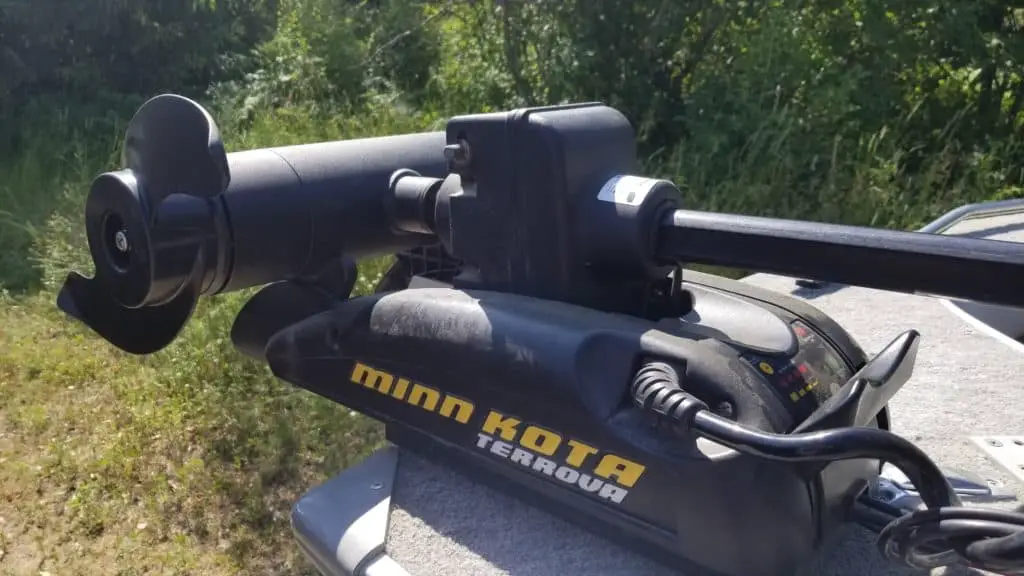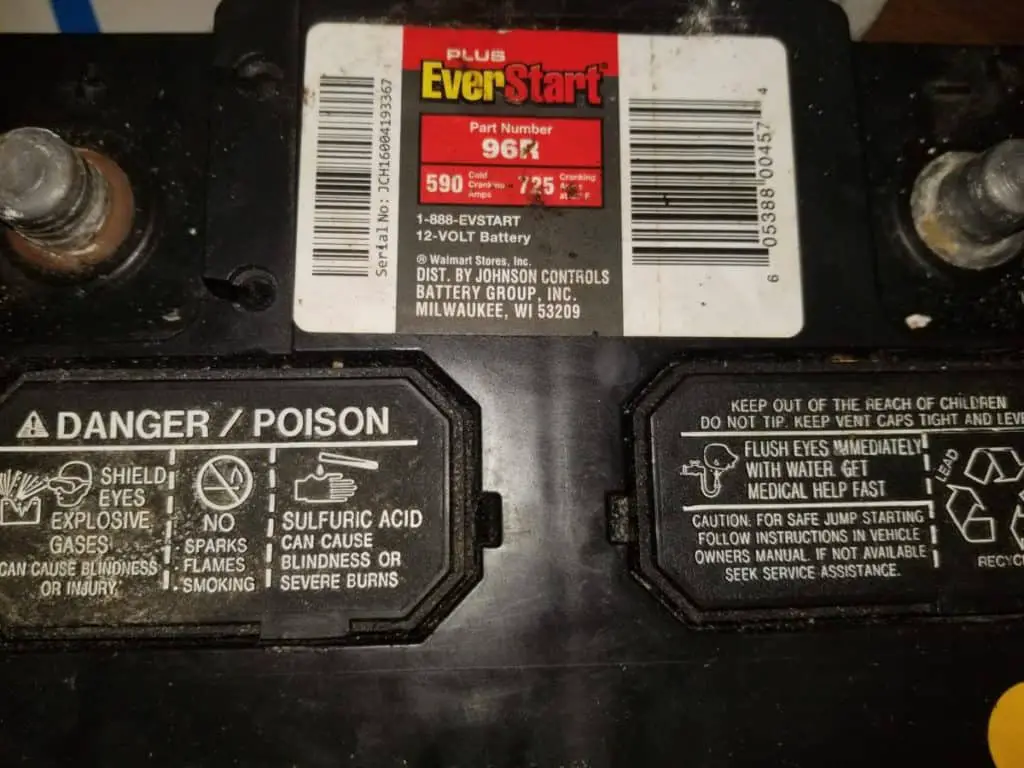You are probably already aware that a car battery is certainly not the ideal option for powering a trolling motor, but what if you had to use one in a pinch?
How long can a car battery power a trolling motor?
A typical mid-sized car battery (60AH / 600CCA) will be able to power most trolling motors on low speed for about 10.5 hours until fully discharged. The pounds of thrust on the trolling motor and speeds faster than the lowest setting will drop that time dramatically.
In the following article I’m going to briefly cover some basic math that led to my conclusions, some inherent limitations with them, and why a car battery is a poor choice for powering your trolling motor.
If you’re in a hurry and just want to locate your trolling motor’s thrust and the estimations of how long you can use a car battery, I placed the chart right below to get you on your way.
How Long (Hours) a Car Battery Can Power a Trolling Motor (100% Discharge)
| Thrust and Speed w/Amps | Car Battery: 200-315 CCA or 40-60 RC or 36-46.2 AH | Car Battery: 315-550 CCA or 60-85 RC or 46.2-58.8 AH | Car Battery: 550-1,000 CCA or 80-190 RC or 58.8-111 AH |
|---|---|---|---|
| 30 lbs, Max Speed (30 Amps) | 0.68 - 0.92 | 0.92 - 1.23 | 1.23 - 2.64 |
| 30 lbs, Med. Speed (15 Amps) | 1.57 - 2.12 | 2.12 - 2.83 | 2.83 - 6.07 |
| 30 lbs, Low Speed (5 Amps) | 5.87 - 7.92 | 7.92 - 10.58 | 10.58 - 22.67 |
| 40-70 lbs, High Speed (40 Amps) | 0.48 - 0.65 | 0.65 - 0.87 | 0.87 - 1.87 |
| 40-70 lbs, Med. Speed (20 Amps) | 1.11 - 1.5 | 1.5 - 2 | 2 - 4.3 |
| 40-70 lbs, Low Speed (5 Amps) | 5.87 - 7.92 | 7.92 - 10.58 | 10.58 - 22.67 |
| 80-100 lbs, High Speed (50 Amps) | 0.37 - 0.5 | 0.5 - 0.67 | 0.67 - 1.43 |
| 80-100 lbs, Med. Speed (25 Amps) | 0.85 - 1.15 | 1.15 - 1.53 | 1.53 - 3.29 |
| 80-100 lbs, Low Speed (5 Amps) | 5.87 - 7.92 | 7.92 - 10.58 | 10.58 - 22.67 |
Example of Calculations
I’ll only do one of these examples, as doing each of them would lead to a tedious article. If you’re wondering where I got my numbers for the amp-hour ratings of car batteries, I have an article here which shows how I extrapolated numbers from a charging data sheet from a battery charger manufacturer.
We’re assuming a 20-hour discharge rate on the car batteries.
We’re also going to be taking into account Peukert’s Law since the amperage being demanded by the trolling motor is large relative to the overall capacity of a car battery. The higher the draw on a battery, the less potential you’ll get out of it when you’re trying to measure it’s capacity.
We’re assuming a 1.2 Peukert Constant for a lead-acid car battery.
The amperage of the trolling motors was courtesy of www.trollingmotors.net.
Formula being Used: Total Time = 20((Battery AH)/(Trolling Amps * 20))^(1.2) ==> Divide the answer by 2 to still be able to possibly start your car.
Example using a 58.8AH battery:
So, a 30lb thrust trolling motor requires 30 amps at max speed.
20((58.8AH / (30amps * 20))^1.2) = 1.23 hours (74 minutes) total for 100% discharge, or 37 minutes for 50%.
If we compare it to the expected reserve capacity of a 58.8AH battery, we see that it’s 85 minutes. Reserve capacity how long a battery can power something at a 25amp discharge rate. It definitely seems ballpark to me.
If we were to substitute a trolling motor amperage of 25 (like that on a reserve capacity test), the result is 1.53 hours, or 91 minutes. Only 6 minutes off from the 85 estimate.
That’s close enough for me, but just remember that these are educated estimates and not exact numbers.
Capacity of a Car Battery to Power a Trolling Motor
I’m going to ignore the shortcomings of a car battery for the purpose of powering a trolling motor for the time being. We’ll just set it on the shelf and we’ll get to it later in this article.

I’m only focused on how much energy a car battery can provide to power the trolling motor.
Amp Hour Estimates Based On Cold Cranking Amps or Reserve Capacity
| If Your Sticker Reads: 200-315 CCA, or 40-60 RC | If Your Sticker Reads: 315-550 CCA, or 60-80 RC | If Your Sticker Reads: 550-1,000 CCA, or 80-190 RC |
| 36 - 46.2 AH | 46.2 - 58.8 AH | 58.8 - 111 |
Since car batteries are starter batteries and are rated in cranking amps (CA), or cold cranking amps (CCA), we can’t simply consult the manufacturer’s sticker to calculate the ampere hours (AH) which are needed to make an estimation of how long it could power any given device.
There is also no hard and fast rule for converting CA/CCA to AH but I did extrapolate some numbers from a car battery manufacturer’s charging data sheets and found the above numbers in the table to be a good ballpark estimate for the equivalent amp hours (AH).
Peukert’s Law
To get a more accurate representation of just how long a car battery can actually power a trolling motor, and not just a rosy picture by simply dividing the battery’s amp hours by the amps required by the motor.
Peukert’s Law basically states that the relative amp hours of a battery are reduced the more of a draw you put on the battery.
For instance, a 50 amp hour battery should be able to provide 1 amp for 50 hours without a problem, and 2 amps for close to 25 hours.
But as you increase the amps being drawn, to say, 25 amps, you’ll likely get just over an hour of use.
The battery simply loses its efficiency in providing energy the more you demand of it at any given period of time.
In the formula that we used to account for Peukert’s Law, I used 1.2 as the “Peukert’s Constant” which is typical for lead acid batteries like your car’s.
Water Conditions and Other Factors that can Affect the Results
If the waves are choppy or the current is strong, your trolling motor is going to require more energy from your car battery to perform as intended. This will further shorten your expected time of use.
Also, a boat has a tendency to not be as level as a car when in use. Things are regularly rocking and getting slammed around.

This can also take its toll on your car battery’s performance. Many have theorized that the sulfation that occurs within a battery on the plates is knocked loose by the slamming and is forced to pool together in the parts of the battery that are the lowest point of gravity.
Since the plates within a car battery extend to lower than those of a deep cycle battery and are closer together, the sulfate crystals then can cause internal shorts within the cells by bridging the gaps between the plates.
You might also find yourself gaining more time than the chart above estimates. If your battery has a higher AH equivalency than 50, you’ll get more time, or if your battery’s “Peukert Constant” is less than 1.2, you’ll get more time.
Finally, the amperage estimates of the trolling motors are just averages within common trolling motors on the market in those individual thrust categories.
If your motor requires fewer amps, you’ll get more time. If it requires more, you might be stranded in the water.
Why a Car Battery is NOT Good to Use in a Trolling Motor
I’ve already hinted that a car battery isn’t ideal for a trolling motor, and the reason behind this is that a trolling motor is either a true “deep cycle” battery, or a hybrid between a “deep cycle” and a “starter/cranking battery”.

A car battery, however, is simply a “starter/cranking” battery.
It is engineered and designed to do one thing: start and engine by releasing a high surge of amperage for a few seconds, and then to be immediately recharged by the car’s alternator.
A car battery not designed to continuously power something.
A car battery has thin lead plates that are close together with a lot of surface area to quickly allow current to flow in a circuit.
It is a sprinter in the battery world. Sure, it can run an endurance race, but it isn’t designed for it, doesn’t like it, and will have a very short career if you make it do long races.
A marine battery, on the other hand, has thicker lead plates with less surface area and is designed to release a moderate amount of energy over a long period of time.
It’s like a middle distance or endurance athlete in the battery world. It isn’t the best at sprinting, but it can go the long-haul over and over again.
Deep-cycle batteries also have an alloy on their lead plates that prevent sulfation and make it easier for chargers to knock it off when charging. Car batteries lack this and sulfation builds up quickly with every discharge.
When enough sulfation builds up, it prevents the battery from charging properly and discharging properly due to increased internal resistance, and the sulfation can also short out the cells as it bridges the gaps between the plates.
If you choose to do a deep discharge of a car battery, don’t expect to get more than 10-12 uses out of it. Each time you do it, you weaken it as well.
Now that we have covered that the lifespan of the battery is reduced by making it drain lower than 90% of its full charge, remember that they cost money and you’ll be replacing them quickly by using them in a manner that causes a great depth of discharge.
It’s also taxing on your car’s alternator when you return the battery under your hood. If you have a discharged battery, your alternator and voltage regulator are working overtime to pump as much current as possible into the battery to bring it back up to a fully charged state.
This extra work causes excess heat, and is especially harmful if you’re only letting your car run at idle as you recharge your battery. It is best to drive your car if you are attempting to recharge a weakened battery.
Finally, if you’re relying on that car battery to also get you home from the lake, you’re always going to be stressing about whether or not you’ll be able to actually start your car at the end of the evening.
Who can truly enjoy a day out on the water when you are stressing about not being able to get home?
Recap of why you should NOT use a car battery to power a trolling motor
- Guaranteed to reduce the lifespan of the battery.
- The costs associated with replacing the battery
- Hard on the car’s alternator when you put the battery back in the car (heat, especially at idle).
- Vibrations, shaking with the waves, angles other than being level (cause sulfation crystals to accumulate heavily in at the lowest point of gravity within the cells and can cause a short within the cells of the battery).
Related Questions:
Can you use a Regular Car Battery for a Trolling Motor?
A car battery is 12-volts and can power your trolling motor. However, the length of time you’ll be able to do so will be a fraction of the time a designated deep cycle battery could do it, and the car battery will have a dramatically shorted lifespan if you choose to deep-cycle it for trolling applications.
What Size Battery do I Need for my Trolling Motor?
For minimal trolling, you’ll be able to get away with a group size 24M battery which will have about 70-80AH. If you rely on your trolling motor a fair amount, a group 27M would probably work well and sports about 80-90AH. Lots of trolling will be best with a group size 31M battery which has about 90-110AH.
The higher the amp hour (AH) rating, the more time you’ll get out of it. The group size is just a reference to the physical dimensions of the battery.
How much do Trolling Motor Batteries Weigh?
Trolling motor batteries typically come in sizes 24M, 27M, and 31M. The 24M batteries will generally weigh 40-50lbs. The 27M batteries will generally weigh 50-60lbs. The group 31M batteries will generally weigh 60-70lbs. The group size number references the physical dimensions of the battery.
